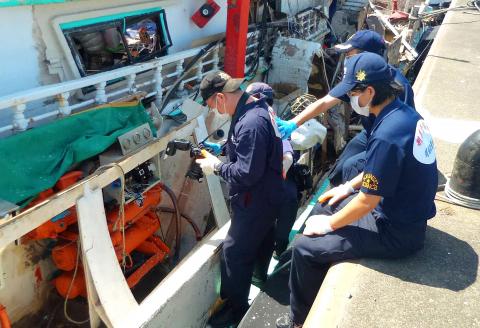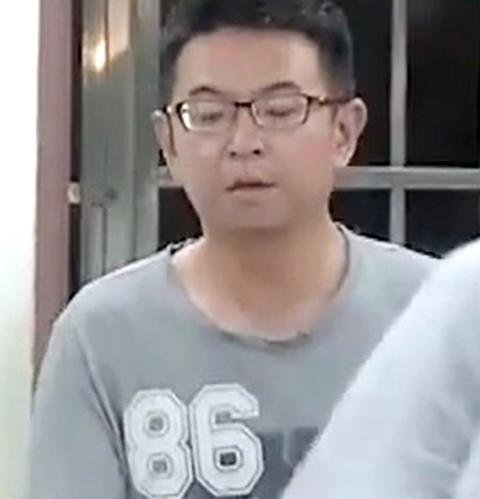Prosecutors and investigators yesterday inspected the damaged Taiwanese fishing vessel Hsiang Li Sheng (翔利昇), which was hit by a Hsiung Feng III missile in the Taiwan Strait on Friday and called on a leading missile expert to provide technical information as a judicial probe into the missile’s launch continued.
After overnight questioning on Friday by the Kaohsiung District Prosecutors’ Office, second-class petty officer Kao Chia-chun (高嘉駿) and chief petty officer Chen Ming-hsiu (陳銘修), the navy officers allegedly responsible for the missile’s launch, were both released yesterday morning after posting bail of NT$300,000.
The junior officers were listed as defendants following the death of Huang Wen-chung (黃文忠), the captain of the Hsiang Li Sheng, who died when the missile struck the vessel.

Photo: CNA
The two men are to be charged with professional negligence causing death, prosecutors said, adding that they would also be charged under the Criminal Code of the Armed Forces (陸海空軍刑法) for the destruction of military property.
Kao and Chen’s superior officers on the Chinchiang corvette, Lieutenant Commander Lin Po-tse (林伯澤) and Lieutenant Junior Grade Hsu Po-wei (許博為) — who was responsible for the ship’s weapons systems — were also detained for questioning and later released pending further investigation.
Meanwhile, the Ministry of Justice has formed a prosecutors’ task force to look into the incident.

Photo: Huang Chien-hua, Taipei Times
Taiwan High Prosecutors’ Office Director-General Wang Tien-sheng (王添盛) traveled to Kaohsiung to lead the investigation.
Wang and his task force brought in a leading missile scientist from the National Chungshan Institute of Science and Technology (CSIST), the nation’s top military research center, which developed the supersonic “aircraft carrier killer” Hsiung Feng III missile.
The CSIST scientist, who has not been named to protect his identity, provided information on the missile’s operation and functioning, its system specifications and other technical data, to aid in the investigation.
Wang yesterday led a team of prosecutors and investigators aboard the Hsiang Li Sheng for further examination and to search for evidence after the boat was towed to the Shinda Harbor (興達港) in Kaohsiung’s Cieding District (茄萣).
Following yesterday’s examination, prosecutor Liu Chun-liang (劉俊良) announced the preliminary findings of the investigation.
“The damage to the ship was consistent with an impact by a highly mobile projectile traveling at a very rapid velocity,” he said, adding that there was no sign of destruction by an ordnance explosion.
“Based on evidence and trajectory studies, the projectile struck the ship from the bow direction, to the right of the pilot’s section, and it exited in the stern on the left side,” he said, giving a revised picture from initial reports on Friday.
An examination of Huang’s body by pathologists and prosecutors indicated that he sustained a fatal head wound, likely on impact from the missile.
The prosecutors’ task force also said it would investigate possible leaks of classified information, or if there were military personnel acting as “informants” to Chinese Nationalist Party (KMT) Policy Committee executive director Alex Tsai (蔡正元) during the missile incident, as Tsai appeared to have knowledge of the incident before it was confirmed by Premier Lin Chuan (林全) on Friday morning.
Prosecutors said the matter has serious implications for national security and must be investigated to find out if there was any illegal conduct.

SECURITY: As China is ‘reshaping’ Hong Kong’s population, Taiwan must raise the eligibility threshold for applications from Hong Kongers, Chiu Chui-cheng said When Hong Kong and Macau citizens apply for residency in Taiwan, it would be under a new category that includes a “national security observation period,” Mainland Affairs Council (MAC) Minister Chiu Chui-cheng (邱垂正) said yesterday. President William Lai (賴清德) on March 13 announced 17 strategies to counter China’s aggression toward Taiwan, including incorporating national security considerations into the review process for residency applications from Hong Kong and Macau citizens. The situation in Hong Kong is constantly changing, Chiu said to media yesterday on the sidelines of the Taipei Technology Run hosted by the Taipei Neihu Technology Park Development Association. With

CARROT AND STICK: While unrelenting in its military threats, China attracted nearly 40,000 Taiwanese to over 400 business events last year Nearly 40,000 Taiwanese last year joined industry events in China, such as conferences and trade fairs, supported by the Chinese government, a study showed yesterday, as Beijing ramps up a charm offensive toward Taipei alongside military pressure. China has long taken a carrot-and-stick approach to Taiwan, threatening it with the prospect of military action while reaching out to those it believes are amenable to Beijing’s point of view. Taiwanese security officials are wary of what they see as Beijing’s influence campaigns to sway public opinion after Taipei and Beijing gradually resumed travel links halted by the COVID-19 pandemic, but the scale of

A US Marine Corps regiment equipped with Naval Strike Missiles (NSM) is set to participate in the upcoming Balikatan 25 exercise in the Luzon Strait, marking the system’s first-ever deployment in the Philippines. US and Philippine officials have separately confirmed that the Navy Marine Expeditionary Ship Interdiction System (NMESIS) — the mobile launch platform for the Naval Strike Missile — would take part in the joint exercise. The missiles are being deployed to “a strategic first island chain chokepoint” in the waters between Taiwan proper and the Philippines, US-based Naval News reported. “The Luzon Strait and Bashi Channel represent a critical access

Pope Francis is be laid to rest on Saturday after lying in state for three days in St Peter’s Basilica, where the faithful are expected to flock to pay their respects to history’s first Latin American pontiff. The cardinals met yesterday in the Vatican’s synod hall to chart the next steps before a conclave begins to choose Francis’ successor, as condolences poured in from around the world. According to current norms, the conclave must begin between May 5 and 10. The cardinals set the funeral for Saturday at 10am in St Peter’s Square, to be celebrated by the dean of the College